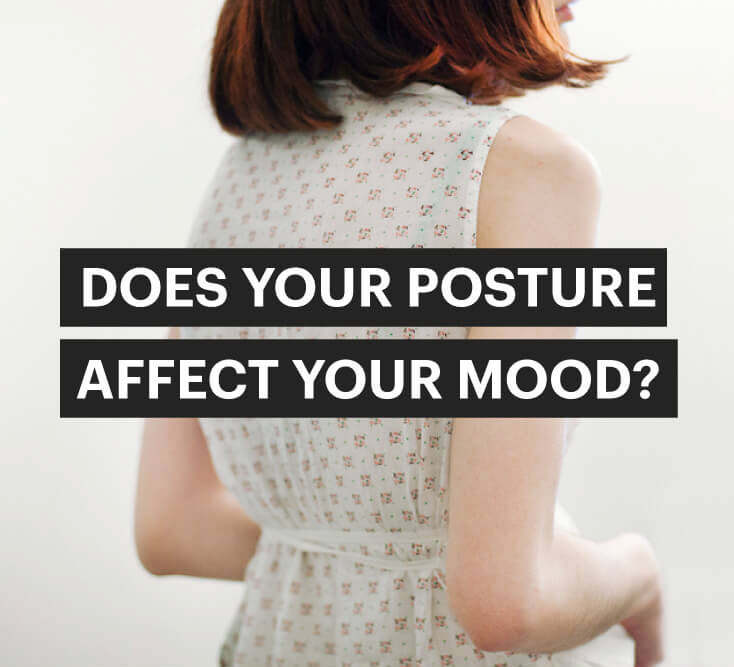
Thanks in no small part to a reliance on and addiction to technology, a sedentary lifestyle has become the norm. As a result, good posture has never been more critical, but unfortunately, our obsession with our smartphones has made many of us develop forward head posture.
Why is this bad? Every time we lean forward 60 degrees, the stress on our necks is increased by approximately 60 pounds. Every time you move your head forward an inch, an extra 10 pounds of weight is added to your neck. As a result, forward head posture leads to chronic pain, numbness in the arms and hands, improper breathing, and pinched nerves. (1)
That’s not all. It turns out; forward head posture doesn’t just affect us physically — it affects our mood as well. Thanks in no small part to our smartphone addiction, aka nomophobia, most of us are continually putting undue strain on our necks and spinal cords, which has adverse effects on our emotions. Amy Cuddy, a professor at Harvard Business School and the author of the forthcoming book “Presence: Bringing Your Boldest Self to Your Biggest Challenges,” and her colleague, Harvard’s Maarten W. Bos, have dubbed this phenomenon iPosture, or iHunch. (2)
How Forward Head Posture Affects Mood and Brain Function
That’s right: Not only do asthma and heart disease begin in your neck, but so does your brain health. For instance, posture has an impact on feelings of stress, mood, memory, and even behavior.
A 2010 study conducted in Brazil examined posture and body image in people with major depressive disorder. Over ten weeks, 34 participants with depression, and 37 healthy volunteers had their attitudes assessed. Researchers found that patients’ perspectives changed, including instances of forwarding head posture, during episodes of depression, and there was a “mild dissatisfaction with body image.” (3)
Further, the Department of Clinical Psychology at the University of Hildesheim in Germany gathered 30 depressed inpatients to “investigate the effects of sitting posture on the tendency of depressed individuals to recall a higher proportion of negative self-referent material.” The findings showed that posture could affect memory.
After being randomly assigned to sit in a slouched or upright position, the people who sat upright showed no bias in word recall, while those who slumped recalled mostly negative words. (4)
Also, poor posture has been shown to affect the stress response. In 2015, Health Psychology: The Official Journal of the Division of Health Psychology, American Psychological Association published the results of a randomized trial on how posture affects stress responses. Seventy-four participants were randomly assigned to either upright or slumped seated position. For the experiment, participants’ backs were strapped to hold the designated area.
The “upright participants reported higher self-esteem, more arousal, better mood, and lower fear, compared to slumped participants.” Also, those sitting in a slumped position “used more negative emotion words, first-person singular pronouns, affective process words, sadness words, and fewer positive emotion words and total words during the speech.” (5)
Researchers concluded that good posture in the face of stress maintains self-esteem, improves mood, increases the rate of speech, and reduces self-focus. Meanwhile, poor posture resulted in more pressure, potentially leading to chronic stress.
Posture even seems to influence behavior. A study in Japan worked to correct elementary students’ attitudes, focusing on all four major components of attitude: feet, buttocks, back, and the entire body. After practicing and promoting a good position in class, not only did posture increase roughly 20 percent to 90 percent in students, but students’ classroom performance improved as well. (6)
A lot of the poor posture out there, whether it’s slumping or forward head posture, is the result of the devices we use. From computers to tablets to smartphones, they all require a different angle to utilize, all of which throw our posture off. And it turns out, the size of device matters — but it’s not what you may think. Instead of larger devices causing more problems, the opposite seems to be true. That’s because the smaller the invention, the more we must move our heads or necks forward.
Cuddy and Bos also conducted their preliminary research on iHunch in their study, “iPosture: The Size of Electronic Consumer Devices Affects Our Behavior.” Using an iPod Touch, iPad, MacBook Pro, and an iMac, participants were assigned one of the devices. Cuddy and Bos found, as they hypothesized, that those working on smaller devices behaved more submissively, while those who used more extensive tools were more assertive. (7)
Forward Head Posture, Asthma and Heart Disease
One of the most prevalent and destructive imbalances has to do with the cervical curve, the natural curve in the vertebrae of the neck. When we lose the proper curvature of the cervical and lumbar curves, we lose as much as 50 percent of our spinal strength.
For every inch that your head is held forward (rather than appropriately balanced over the body), it gains 10 pounds of weight. The muscles of your back and neck have to work that much harder to keep your chin off your chest, and the muscles of your jaw stay in constant contraction, compressing nerves and leading to headaches at the base of the skull or those that mimic sinus headaches.
This “forward head posture,” says University of California’s director of physical medicine and rehabilitation, Rene Cailliet, “can add up to thirty pounds of abnormal leverage…” pulling “the entire spine out of alignment” and “may result in the loss of 30% of vital lung capacity.” (8)
Chiropractor Adam Meade explains that the curve of your cervical vertebrae are referred to as “the arc of life” by neurosurgeons because these bones protect the brain stem and are the thoroughfare for spinal nerves that affect every organ and function in the body. (9)
Subluxation is the term for the compression and irritation of nerves because of misalignments of the Spine. When the cervical curve is misaligned, the spinal cord stretches and shrinks in circumference, Meade says, losing nerve conductivity.
Chiropractors make adjustments to the Spine and help teach clients posture and habits that reverse these misalignments, restoring the body’s natural functions and healing capabilities.
What Causes a Forward Head Posture?
Forward head posture is caused by:
- Computer use
- TV watching
- Video games
- Backpacks
- Trauma
Trauma leading to forward head posture can come in the form of car accidents, slips or falls, or even birthing injury from forceps or vacuums.
A 1999 study published in the November issue of Spine took a look at 985 students from five different high school years and the effects of carrying backpacks. The postural changes that occurred in “the arc of life” were significant with backpack use in every case. The weight of the bag did not matter as much as the age and sex of students. Younger students had the enormous deformity of posture, and the oldest girls also incurred a healthy forward head posture. (10)
At the 1997 Seattle Fibromyalgia International Team Conference, Dr. Herbert Gordon explained that head and neck posture is a significant factor in the fatigue and immune dysfunction in sufferers of fibromyalgia (FMS) and chronic fatigue and immune system dysfunction syndrome patients.
The clusters of small, layered muscles at the top of the Spine can begin to atrophy in as little as 20 minutes, Gordon said, when unused. He reported that a 1985 study found postural problems common in people who suffer from FMS, myofascial pain syndrome, and TMJ. The study found poor sitting and standing posture in 96 percent of the cases, forward head posture in 85 percent of the cases, and forward and rounded shoulders in 82 percent of the evidence. (11)
Dr. Dean Fishman has seen increasing evidence of forwarding head posture in young patients and has termed the condition “text neck.” He says that the degenerative bone changes and abnormal cervical curve in these younger patients are related to the use of handheld devices, such as cell phones, portable video games, and e-readers. (12)
This is important because there are many issues that forward head posture can play a part in. It can cause:
- Aches, fatigue, pain
- Asthma
- Disc compression
- Early arthritis
- Headaches
- TMJ (temporomandibular joint) pain
- Altered blood flow
- Fibromyalgia
Forward head posture may also contribute to carpal tunnel syndrome.
Nobel Prize recipient Dr. Roger Sperry says that “the movement of the spine generates 90 % of the stimulation and nutrition to the brain.” Only 10 percent of the brain’s energy goes into thinking, metabolism, and healing, while 90 percent of brain energy goes into processing and maintaining the body’s relationship with gravity, Sperry demonstrated.
As forward head posture decreases lung capacity, it can lead to asthma, blood vessel problems, and heart disease. The oxygen deficit affects the entire gastrointestinal system and can reduce endorphin production. This turns the perception of non-painful sensation into pain experiences, says Dr. Fishman.
Wellness or corrective care chiropractor can measure the curve of your “arc of life,” give you regular adjustments, lead you in spinal rehabilitation exercises, and teach you postural and working habits that will significantly improve your health and quality of life.
How to Improve Posture
The good news is there are many steps you can take to correct your slumping or forward head posture. For instance, you can try Egoscue, a postural therapy designed to eliminate chronic pain without drugs or surgery. It’s a great way to improve posture, which can also relieve tension headaches as a bonus. Chiropractic adjustments can also help relieve joint pain and promote a better position.
Of course, you can always incorporate posture exercises to correct that pesky forward head posture and improve your mood and mental health. These include:
- arm circles
- arm closes
- cats and dogs
- lateral raises (straight and bent)
- rows
- pull-ups
Final Thoughts on Slumped and Forward Head Posture
- Forward head posture leads to chronic pain, numbness in the arms and hands, improper breathing, and pinched nerves. But that’s not all. It can also affect our mood.
- Poor posture also has been shown to affect depression, memory, stress response, self-esteem, body image, and even brain function and behavior.
- You can improve posture through Egoscue, chiropractic adjustments, and posture exercises like arm circles, cats and dogs, lateral raises, rows, and pull-ups.







